Quantifying the Effects of Wind Turbulence on CO2 Flux Measurement in a Closed Chamber
Abstract
1. Introduction
2. Materials and Methods
2.1. Experimental Site Description
2.2. Experimental Materials
2.3. Calculation of Related Variables
2.4. Measured Value
2.5. Calculated Value
2.6. Experiment Procedure
2.7. Data Analysis
3. Results
3.1. Wind Turbulence Intensity
3.2. CO2 Within the Calibration Device
3.3. Measurement Performance Evaluation of Closed Chamber
3.4. Relationship Between CO2 Flux and Wind Turbulence Measured in Closed Chamber
3.5. Measurement Deviation of Closed Chamber
4. Discussion
5. Conclusions
Author Contributions
Funding
Institutional Review Board Statement
Informed Consent Statement
Data Availability Statement
Acknowledgments
Conflicts of Interest
Appendix A
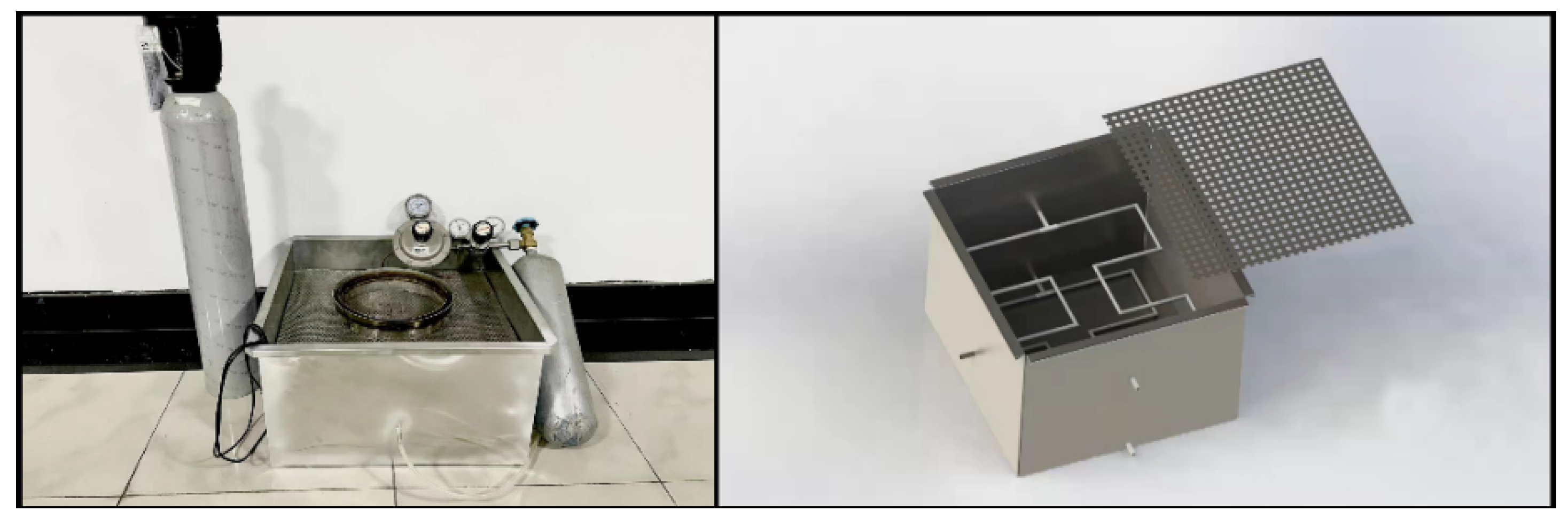
| Soil Medium | Fitted Type | Fitted Equation | R2 |
|---|---|---|---|
| sandy soil | Linear fitting | y= −0.356x + 1.872 | 0.003 |
| Quadratic fitting | y = 2.776 − 4.185x − 3.820 × 2 | 0.002 | |
| loam | Linear fitting | y= −0.204x + 2.015 | 0.004 |
| Quadratic fitting | y = 3.558 − 6.584x − 6.470 × 2 | 0.018 | |
| loess | Linear fitting | y= −0.225x + 1.779 | 0.003 |
| Quadratic fitting | y = −0.466 + 11.479x − 14.604 × 2 | 0.074 | |
| quartz sand | Linear fitting | y = −1.164x + 2.208 | 0.027 |
| Quadratic fitting | y = −2.730 + 23.462x − 29.732 × 2 | 0.053 |
| Soil Medium | Wind Condition | Wind Speed (m s−1) | Flux Error |
|---|---|---|---|
| sandy soil | W1 | 0.335 | −0.217 |
| W2 | 0.357 | −0.182 | |
| W3 | 0.391 | −0.218 | |
| W4 | 0.512 | −0.213 | |
| W5 | 0.639 | −0.179 | |
| loam | W1 | 0.391 | −0.087 |
| W2 | 0.429 | −0.139 | |
| W3 | 0.481 | −0.129 | |
| W4 | 0.528 | −0.143 | |
| W5 | 0.584 | −0.131 | |
| loess | W1 | 0.284 | −0.194 |
| W2 | 0.368 | −0.111 | |
| W3 | 0.442 | −0.090 | |
| W4 | 0.463 | −0.172 | |
| W5 | 0.523 | −0.224 | |
| quartz sand | W1 | 0.328 | −0.271 |
| W2 | 0.364 | −0.104 | |
| W3 | 0.440 | −0.229 | |
| W4 | 0.484 | −0.340 | |
| W5 | 0.512 | −0.289 |
References
- Pourbakhtiar, A.; Poulsen, T.G.; Wilkinson, S.; Bridge, J.W. Effect of Wind Turbulence on Gas Transport in Porous Media: Experimental Method and Preliminary Results. Eur. J. Soil Sci. 2017, 68, 48–56. [Google Scholar] [CrossRef]
- Bond-Lamberty, B.; Thomson, A. Temperature-Associated Increases in the Global Soil Respiration Record. Nature 2010, 464, 579–582. [Google Scholar] [CrossRef] [PubMed]
- Bowling, D.R.; Massman, W.J. Persistent Wind-Induced Enhancement of Diffusive CO2 Transport in a Mountain Forest Snowpack. J. Geophys. Res. Biogeosci. 2011, 116, G04006. [Google Scholar] [CrossRef]
- Menon, S.; Denman, K.L.; Brasseur, G.; Chidthaisong, A.; Ciais, P.; Cox, P.M.; Dickinson, R.E.; Hauglustaine, D.; Heinze, C.; Holland, E.; et al. Couplings Between Changes in the Climate System and Biogeochemistry; Lawrence Berkeley National Lab. (LBNL): Berkeley, CA, USA, 2007.
- Zhou, G.; Zhou, X.; Zhang, T.; Du, Z.; He, Y.; Wang, X.; Shao, J.; Cao, Y.; Xue, S.; Wang, H.; et al. Biochar Increased Soil Respiration in Temperate Forests but Had No Effects in Subtropical Forests. For. Ecol. Manag. 2017, 405, 339–349. [Google Scholar] [CrossRef]
- Feng, L.; Jiang, J.; Hu, J.; Zhu, C.; Wu, Z.; Li, G.; Chen, T. Global Spatial Projections of Forest Soil Respiration and Associated Uncertainties. Forests 2024, 15, 1982. [Google Scholar] [CrossRef]
- Jiang, J.; Feng, L.; Hu, J.; Liu, H.; Zhu, C.; Chen, B.; Chen, T. Global Soil Respiration Predictions with Associated Uncertainties from Different Spatio-Temporal Data Subsets. Ecol. Inform. 2024, 82, 102777. [Google Scholar] [CrossRef]
- Feng, L.; Jiang, J.; Hu, J. Underestimation of Global Soil CO2 Flux Measurements Caused by Near-Surface Winds. Front. For. Glob. Change 2024, 7, 1459948. [Google Scholar] [CrossRef]
- Xu, X.; Du, H.; Zhou, G.; Li, P.; Shi, Y.; Zhou, Y. Eddy Covariance Analysis of the Implications of Drought on the Carbon Fluxes of Moso Bamboo Forest in Southeastern China. Trees 2016, 30, 1807–1820. [Google Scholar] [CrossRef]
- Buragienė, S.; Šarauskis, E.; Romaneckas, K.; Adamavičienė, A.; Kriaučiūnienė, Z.; Avižienytė, D.; Marozas, V.; Naujokienė, V. Relationship between CO2 Emissions and Soil Properties of Differently Tilled Soils. Sci. Total Environ. 2019, 662, 786–795. [Google Scholar] [CrossRef]
- Craine, J.M.; Wedin, D.A. Determinants of Growing Season Soil CO2 Flux in a Minnesota Grassland. Biogeochemistry 2002, 59, 303–313. [Google Scholar] [CrossRef]
- Jacinthe, P.A. Carbon Dioxide and Methane Fluxes in Variably-Flooded Riparian Forests. Geoderma 2015, 241–242, 41–50. [Google Scholar] [CrossRef]
- Knoepp, J.D.; Vose, J.M. Quantitative Comparison of In Situ Soil CO2 Flux Measurement Methods; United States Department of Agriculture, Forest Service, Southern Region Station: Asheville, NC, USA, 2002.
- Luo, Y. Acclimatization of Soil Respiration to Warming in a Tall Grass Prairie. Nature 2001, 413, 622–625. [Google Scholar] [CrossRef] [PubMed]
- Poblador, S.; Lupon, A.; Sabaté, S.; Sabater, F. Temporal and Spatial Decoupling of CO2 and N2O Soil Emissions in a Mediterranean Riparian Forest. Biogeosciences 2017, 14, 4195–4208. [Google Scholar] [CrossRef]
- Zhang, D.; Li, J.; Wu, J.; Cheng, X. Soil CO2 and CH4 Emissions and Their Carbon Isotopic Signatures Linked to Saturated and Drained States of the Three Gorges Reservoir of China. Environ. Pollut. 2022, 293, 118599. [Google Scholar] [CrossRef]
- Pumpanen, J.; Kolari, P.; Ilvesniemi, H.; Minkkinen, K.; Vesala, T.; Niinistö, S.; Lohila, A.; Larmola, T.; Morero, M.; Pihlatie, M.; et al. Comparison of Different Chamber Techniques for Measuring Soil CO2 Efflux. Agric. For. Meteorol. 2004, 123, 159–176. [Google Scholar] [CrossRef]
- Brændholt, A.; Steenberg Larsen, K.; Ibrom, A.; Pilegaard, K. Overestimation of Closed-Chamber Soil CO2 Effluxes at Low Atmospheric Turbulence. Biogeosciences 2017, 14, 1603–1616. [Google Scholar] [CrossRef]
- Lai, D.Y.F.; Roulet, N.T.; Humphreys, E.R.; Moore, T.R.; Dalva, M. The Effect of Atmospheric Turbulence and Chamber Deployment Period on Autochamber CO2 and CH4 Flux Measurements in an Ombrotrophic Peatland. Biogeosciences 2012, 9, 3305–3322. [Google Scholar] [CrossRef]
- Maier, M.; Schack-Kirchner, H.; Aubinet, M.; Goffin, S.; Longdoz, B.; Parent, F. Turbulence Effect on Gas Transport in Three Contrasting Forest Soils. Soil Sci. Soc. Am. J. 2012, 76, 1518–1528. [Google Scholar] [CrossRef]
- Mohr, M.; Laemmel, T.; Maier, M.; Schindler, D. Analysis of Air Pressure Fluctuations and Topsoil Gas Concentrations within a Scots Pine Forest. Atmosphere 2016, 7, 125. [Google Scholar] [CrossRef]
- Xu, L.; Furtaw, M.D.; Madsen, R.A.; Garcia, R.L.; Anderson, D.J.; McDermitt, D.K. On Maintaining Pressure Equilibrium between a Soil CO2 Flux Chamber and the Ambient Air. J. Geophys. Res. Atmos. 2006, 111, D08S10. [Google Scholar] [CrossRef]
- Levintal, E.; Dragila, M.I.; Kamai, T.; Weisbrod, N. Free and Forced Gas Convection in Highly Permeable, Dry Porous Media. Agric. For. Meteorol. 2017, 232, 469–478. [Google Scholar] [CrossRef]
- Moya, M.R.; Sánchez-Cañete, E.P.; Vargas, R.; López-Ballesteros, A.; Oyonarte, C.; Kowalski, A.S.; Serrano-Ortiz, P.; Domingo, F. CO2 Dynamics Are Strongly Influenced by Low Frequency Atmospheric Pressure Changes in Semiarid Grasslands. J. Geophys. Res. Biogeosci. 2019, 124, 902–917. [Google Scholar] [CrossRef]
- Kimball, B.A.; Lemon, E.R. Air Turbulence Effects upon Soil Gas Exchange. Soil Sci. Soc. Am. J. 1971, 35, 16–21. [Google Scholar] [CrossRef]
- Poulsen, T.G. Measuring Horizontal Pore Gas Velocity Profiles in Porous Media in Response to Near-surface Wind Speed and Gustiness. Eur. J Soil Sci. 2018, 69, 997–1007. [Google Scholar] [CrossRef]
- Poulsen, T.G. Linking Below-surface Horizontal Pore Velocity Profiles in Porous Media with Near-surface Wind Conditions and Porous Medium Gas Permeability. Eur. J Soil Sci. 2020, 71, 819–830. [Google Scholar] [CrossRef]
- Soussana, J.F.; Allard, V.; Pilegaard, K.; Ambus, P.; Amman, C.; Campbell, C.; Ceschia, E.; Clifton-Brown, J.; Czobel, S.; Domingues, R.; et al. Full Accounting of the Greenhouse Gas (CO2, N2O, CH4) Budget of Nine European Grassland Sites. Agric. Ecosyst. Environ. 2007, 121, 121–134. [Google Scholar] [CrossRef]
- Jiang, J.; Hu, J. Effect of Wind Turbulence on Monitoring Soil CO2 Flux Using the Closed Gas Chamber Method—OPscience. Environ. Res. Commun. 2022, 4, 075015. [Google Scholar] [CrossRef]
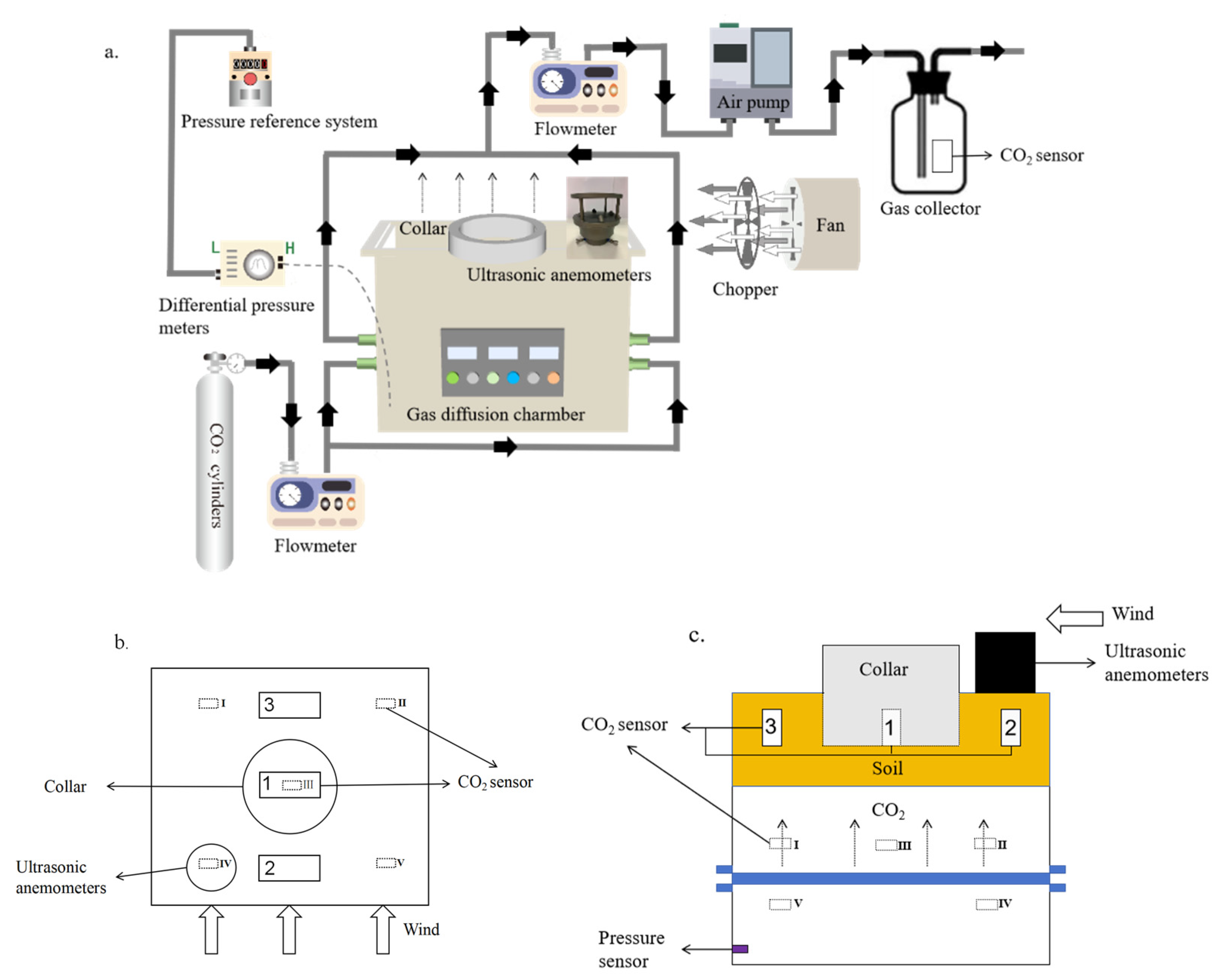

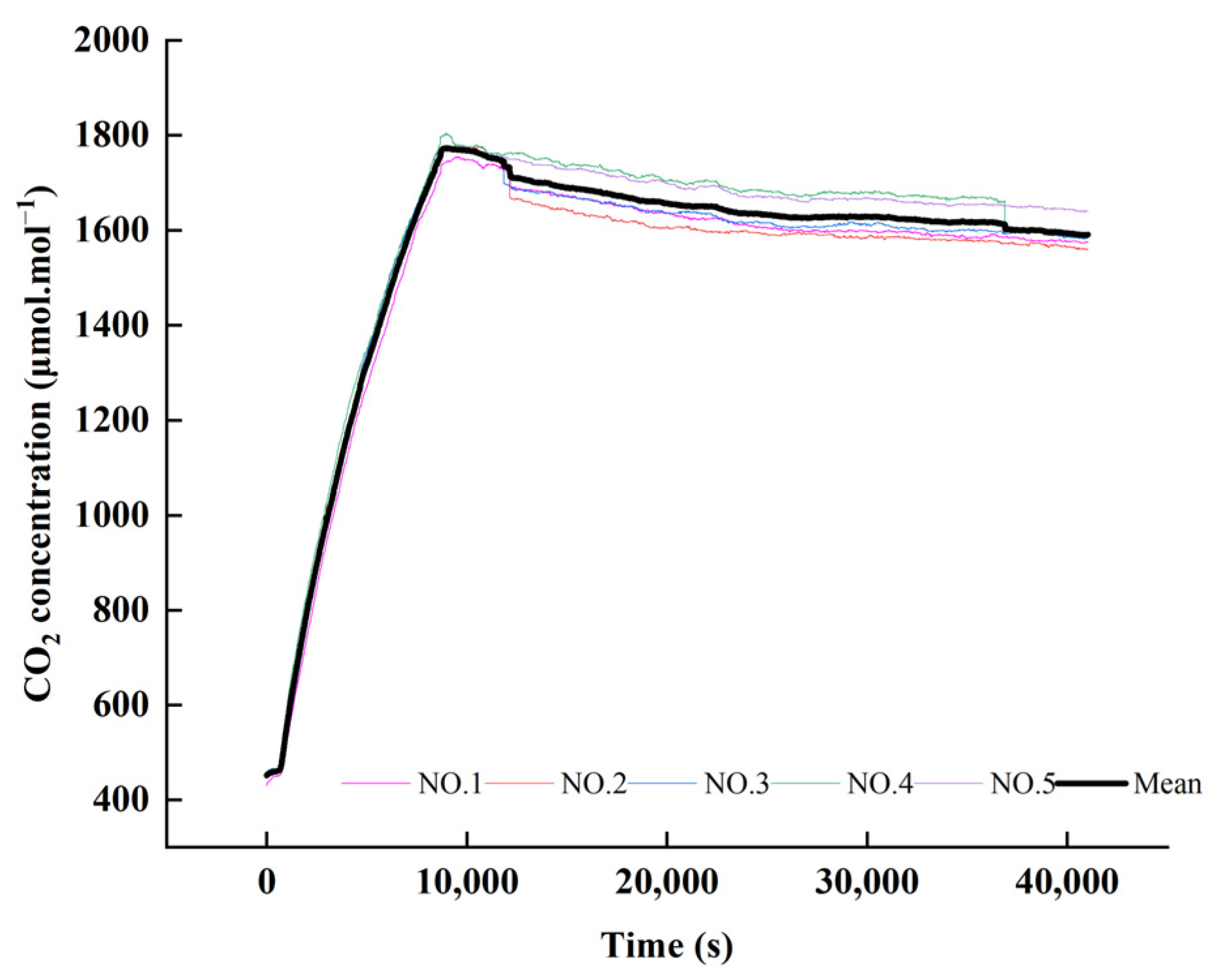
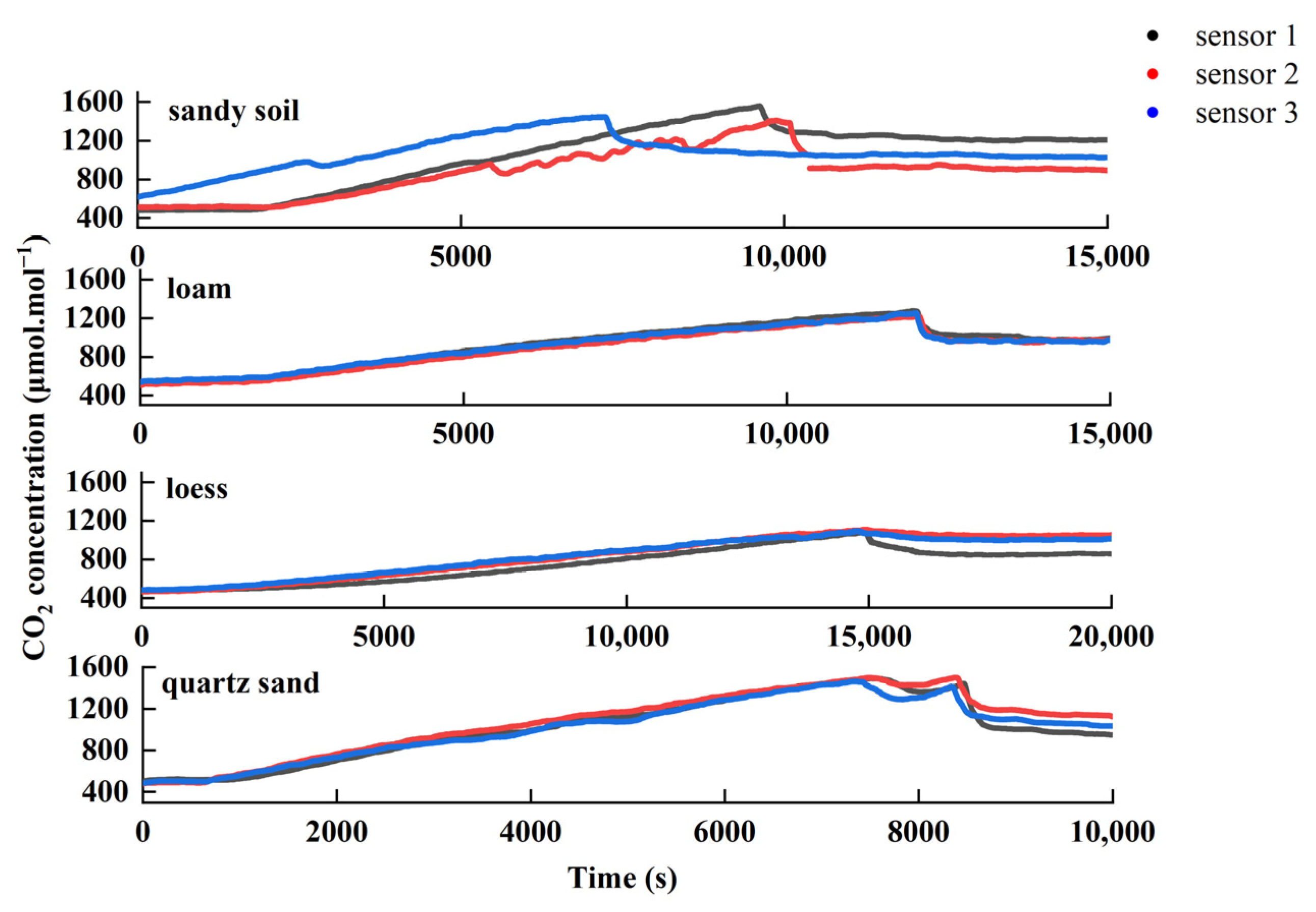
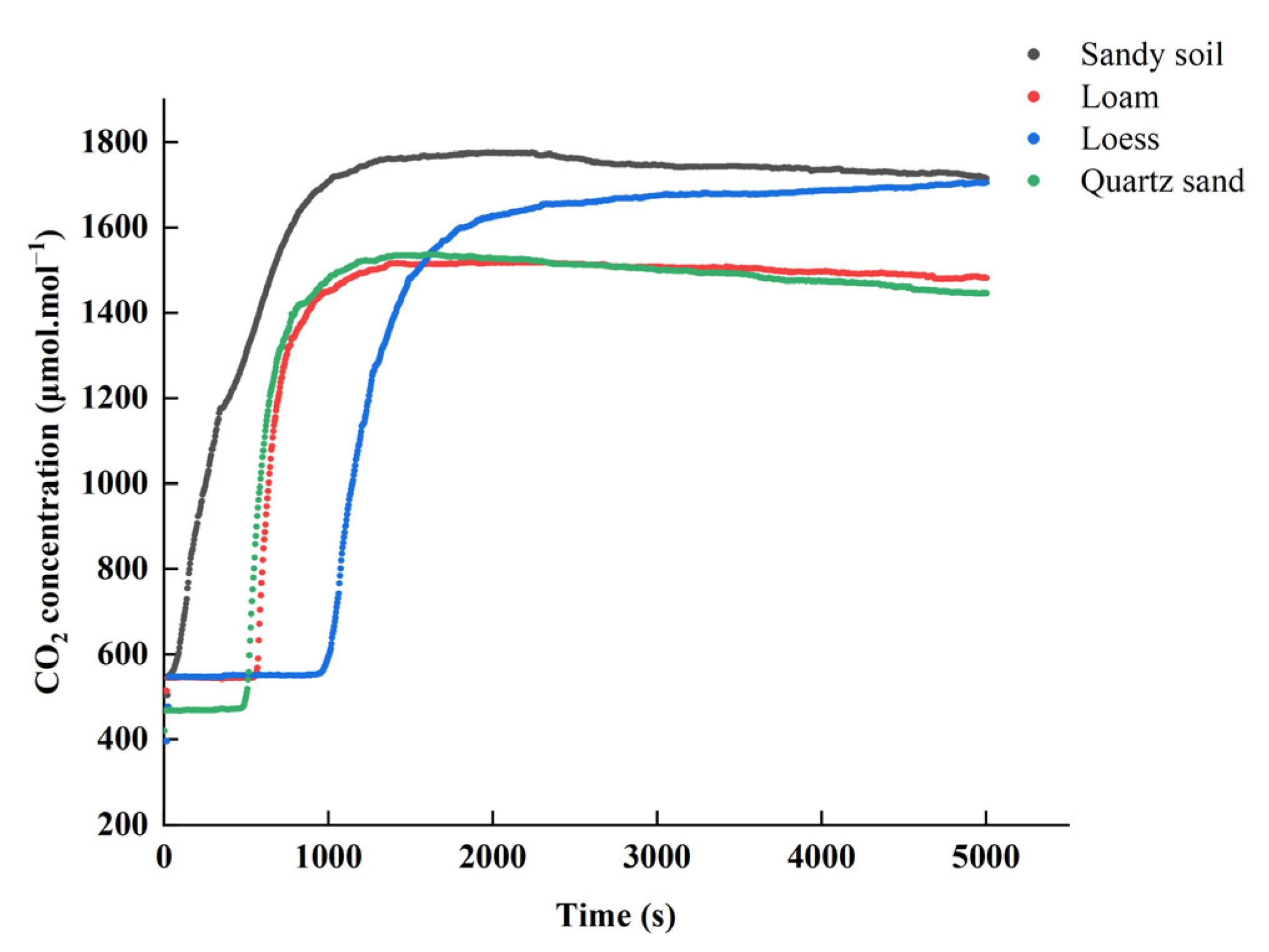
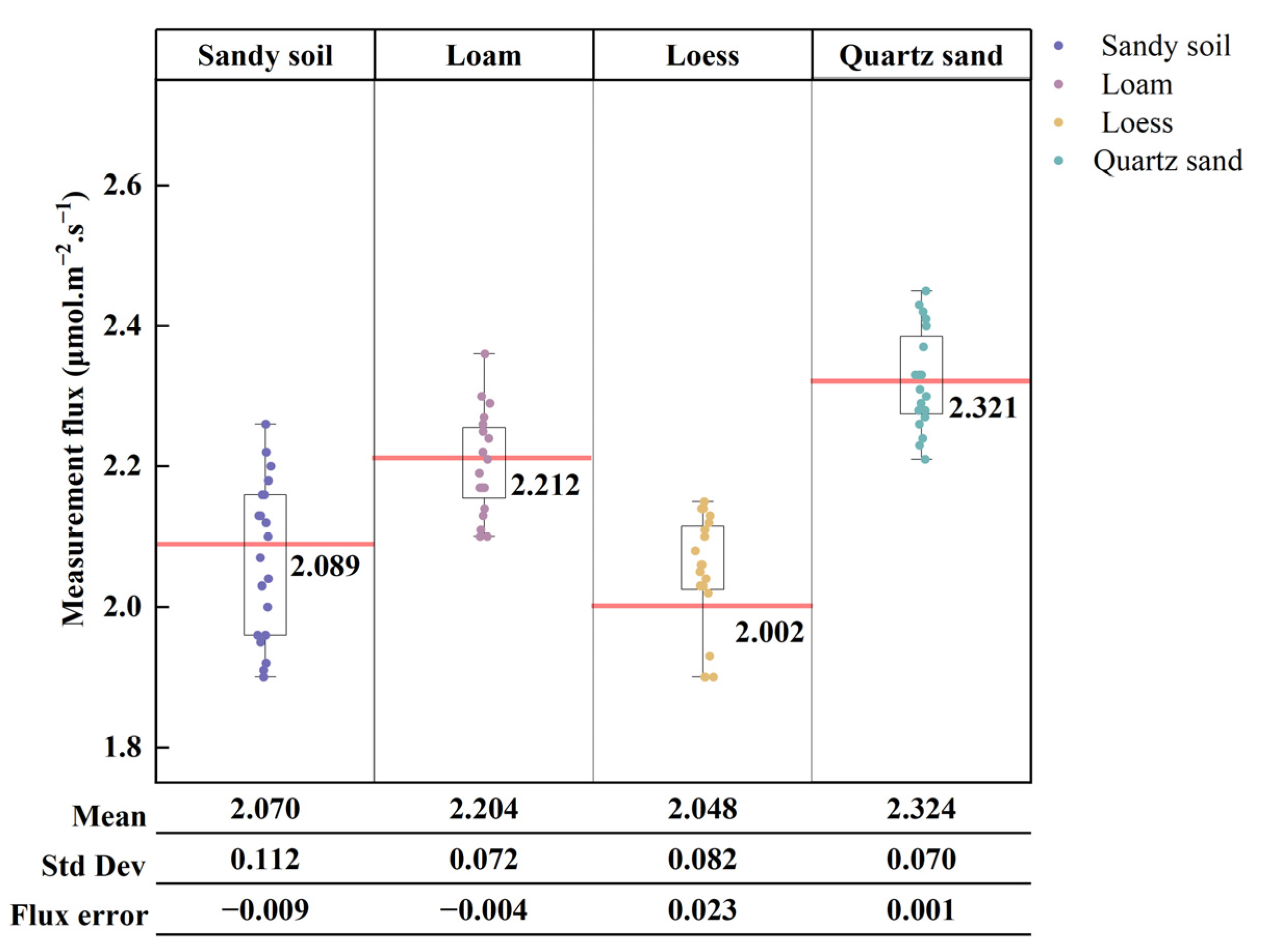

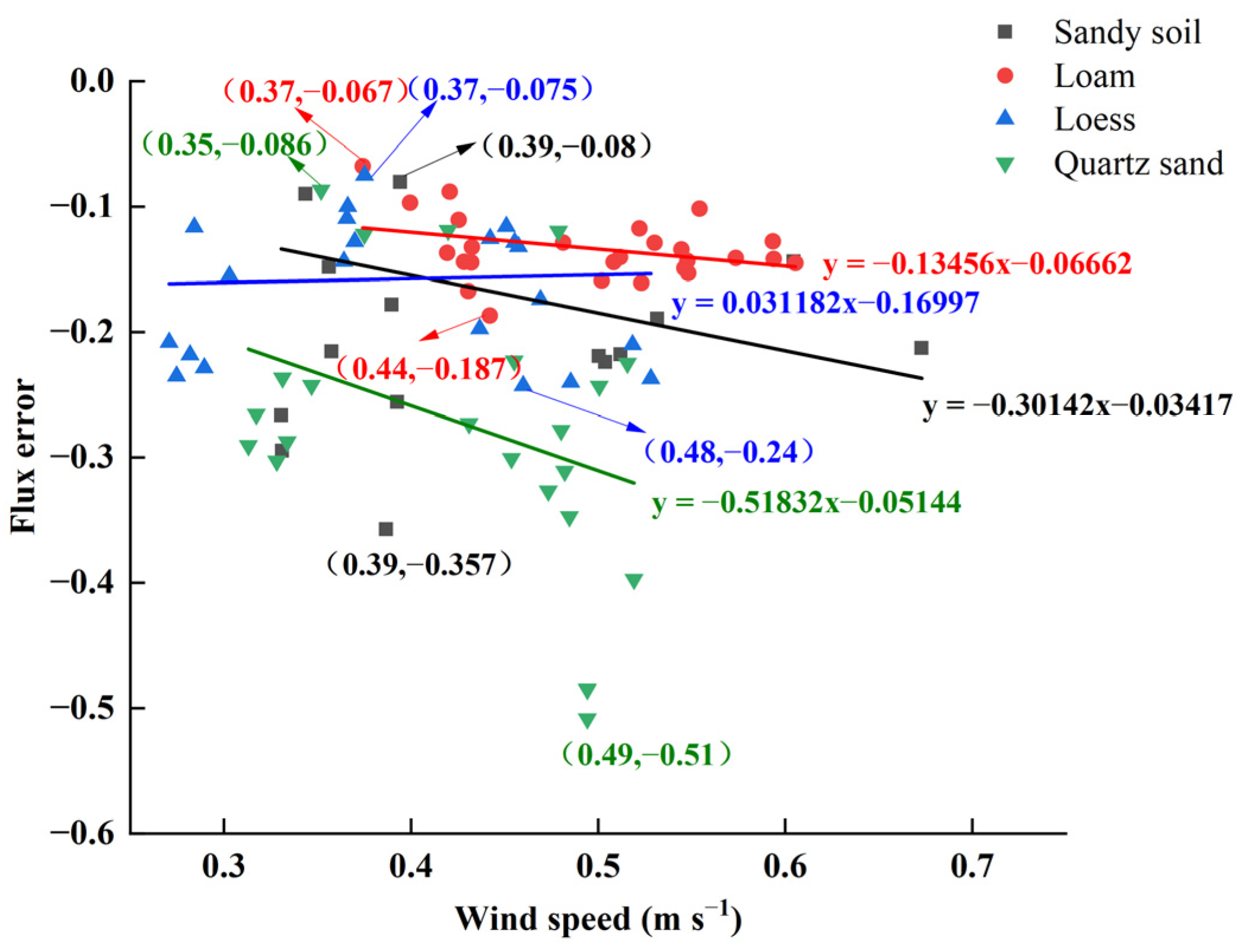

| Soil Medium | d10/mm | d60/mm | Φ/m3 m−3 | Ds/m2 s−1 | ρ/g cm−3 |
|---|---|---|---|---|---|
| sandy soil | 0.063 | 0.111 | 0.402 | 2.180 × 10−6 | 1.851 |
| loam | 0.045 | 0.075 | 0.518 | 3.603 × 10−6 | 2.013 |
| loess | 0.053 | 0.087 | 0.572 | 3.112 × 10−6 | 2.139 |
| quartz sand | 0.170 | 0.355 | 0.471 | 3.477 × 10−6 | 1.820 |
| Wind Condition | Wind Speed (m s−1) | Standard Deviation (m s−1) |
|---|---|---|
| W0 | 0–0.1 | / |
| W1 | 0.33–0.35 | 0.070 |
| W2 | 0.38–0.40 | 0.074 |
| W3 | 0.41–0.43 | 0.067 |
| W4 | 0.50–0.53 | 0.100 |
| W5 | 0.55–0.60 | 0.106 |
Disclaimer/Publisher’s Note: The statements, opinions and data contained in all publications are solely those of the individual author(s) and contributor(s) and not of MDPI and/or the editor(s). MDPI and/or the editor(s) disclaim responsibility for any injury to people or property resulting from any ideas, methods, instructions or products referred to in the content. |
© 2024 by the authors. Licensee MDPI, Basel, Switzerland. This article is an open access article distributed under the terms and conditions of the Creative Commons Attribution (CC BY) license (https://creativecommons.org/licenses/by/4.0/).
Share and Cite
Wu, Z.; Hu, J.; Feng, L.; Jiang, J.; Li, G. Quantifying the Effects of Wind Turbulence on CO2 Flux Measurement in a Closed Chamber. Sustainability 2024, 16, 10501. https://doi.org/10.3390/su162310501
Wu Z, Hu J, Feng L, Jiang J, Li G. Quantifying the Effects of Wind Turbulence on CO2 Flux Measurement in a Closed Chamber. Sustainability. 2024; 16(23):10501. https://doi.org/10.3390/su162310501
Chicago/Turabian StyleWu, Zhiwei, Junguo Hu, Lingxia Feng, Junjie Jiang, and Guangliang Li. 2024. "Quantifying the Effects of Wind Turbulence on CO2 Flux Measurement in a Closed Chamber" Sustainability 16, no. 23: 10501. https://doi.org/10.3390/su162310501
APA StyleWu, Z., Hu, J., Feng, L., Jiang, J., & Li, G. (2024). Quantifying the Effects of Wind Turbulence on CO2 Flux Measurement in a Closed Chamber. Sustainability, 16(23), 10501. https://doi.org/10.3390/su162310501





